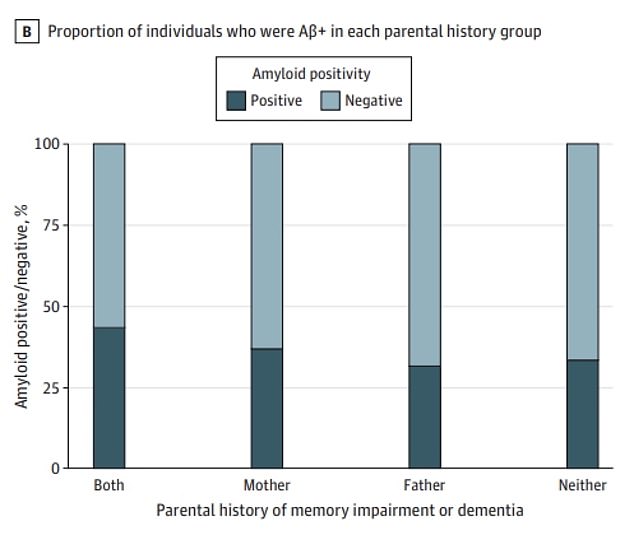You’re more likely to get Alzheimer’s if your mom has it, major study suggests
You are more likely to develop Alzheimer’s disease if your mother has been diagnosed with the disease, compared to if your father has suffered from it, a new study suggests.
Those whose fathers were diagnosed with the degenerative condition early (before age 65) may be at greater risk of developing the disease earlier than the average patient.
Researchers in Massachusetts made the discovery after analyzing brain scans of 4,400 adults with an average age of 70 and without cognitive limitations.
Each brain was scanned for amyloid plaques – a buildup of toxic protein that is thought to be a precursor to Alzheimer’s disease, the most common form of dementia.
Researchers found that people with higher levels of plaques in the brain often had a family history of the disease on their mother’s side.
A study shows that you are more likely to develop dementia if your mother has had the disease at some point in her life
However, higher-than-average amyloid levels were also observed in the brains of those who had fathers diagnosed with Alzheimer’s at age 65 or younger.
Amyloid plaques are thought to cause the disease by disrupting communication between brain cells, causing the organ to stop functioning properly.
They accumulate silently over time and can remain in the brain for years before symptoms of the disease appear.
The researchers suggested that patients whose mothers had dementia might be at greater risk because of specific mitochondria, small structures in cells that make energy.
These are only inherited from the mother, but carry their own DNA, including any mutations that may prevent them from working properly.
Researchers also theorized that the risk could be related to errors in the X chromosome, which are always passed on from the mother.
Fathers can also pass on an X chromosome, making their offspring female, but this only happens in 50 percent of newborns.
Dr. Hyun-Sik Yang, a neurologist at Mass General Brigham who led the study, said, “Our study found that if participants had a family history on their mother’s side, higher amyloid levels were observed.”
“If your father had symptoms early on, that is associated with elevated levels in the offspring,” added neurologist Dr. Mabel Seto, who was also involved in the study.

The graph above shows the percentage positive and negative for amyloid plaques
Alzheimer’s disease affects approximately seven million Americans and is the seventh leading cause of death in the US.
The condition is believed to be a largely hereditary disease, with studies showing between 60 and 80 percent of patients have a family history.
It is believed that those who have a parent or relative with the disease are two to fifteen times more likely to develop the condition, depending on the number of family members affected.
Previous studies have also shown that the maternal line may have a greater impact on disease transmission than the paternal line.
Celebrities who have revealed a history of Alzheimer’s in their family include Peter Gallagher, who cared for his mother for 20 years while she suffered from the disease.
He previously said: ‘A diagnosis of Alzheimer’s can be as devastating to the caregiver as it is to the person being diagnosed.’
For the latest article, published today in JAMA Neurologyresearchers extracted data from the Anti-Amyloid Treatment in Asymptomatic Alzheimer’s (A4) study.
This involved scanning the brains of adults at locations in the US, Europe and Japan between April 2014 and December 2017 for amyloid plaques.
Patients tended to be from a non-white ethnic background, researchers said, which may have affected the results.
Adults were not followed for years after the study, so it was not clear how many people actually developed dementia.
Although amyloid plaques are the leading hypothesis for the cause of dementia, others suggest that their role is less important, and instead point to blood vessel damage as the main cause.
The number of adults with Alzheimer’s disease in the US is expected to rise to 12.7 million by 2050 due to an aging population and increasingly unhealthy lifestyles.
The disease normally begins in the mid-70s, but can rarely occur in people between the ages of 40 and 50.
Symptoms start as trouble remembering recent events or conversations, repeating questions, or trouble remembering where you put things.
In later stages, the disease causes loss of awareness of one’s surroundings, an inability to communicate coherently, and difficulty swallowing or eating.
